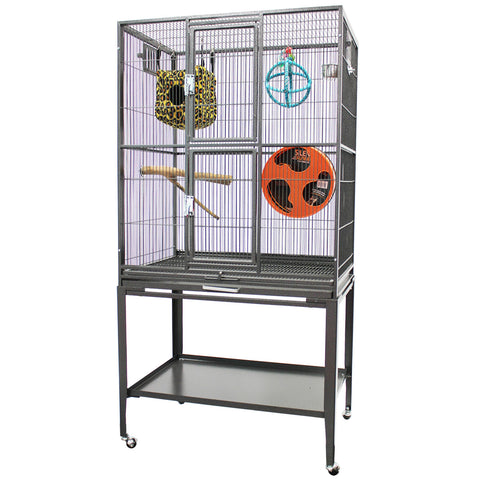
Sugar gliders are active creatures and require plenty of room in their cage. As tree-dwelling animals, they are well adapted to jumping, climbing, and vertical movement. The amount of vertical space is more important than the width or square footage of the cage. A good cage size for a pair of sugar gliders should be at least 35 inches tall and have about 12 square feet of interior space (24” x 24” x 35”). It is recommended to provide a cage with wire spacing no more than 1/2 inch wide, to prevent escape.
Our most popular sugar glider cages are the Borneo Cage, Congo Cage, and Brisbane Cage but we offer other models as well. These cages are manufactured with quality materials and experienced workmanship by the world-renowned HQ Cage Company. The cages are constructed of sturdy wrought-iron, making them the most durable sugar glider cages on the market. The hammer-tone powder coat finish protects against rust for many years.
Gliders have opposable thumbs and can climb easily on both horizontal and vertical bars. Claims that cages must have horizontal bars or a specific cage finish are not true, as sugar gliders have no problem climbing on vertical wires and Exotic Nutrition cages have been used successfully for many years.
To enrich the lives of sugar gliders, it is important to provide nest pouches, toys, and other accessories in their cage. Nest pouches are cloth sacks that can be hung from the sides or roof of the cage to provide a safe and private space for gliders to sleep or retreat to. It is recommended to hang multiple pouches in the cage to provide different sleeping areas. Toys should be provided to promote interest, curiosity, and movement. These can include toys that encourage foraging, branches, ropes, cage plants, shelves, platforms, and ladders. Toys are essential for mental and physical health, as they provide entertainment and stimulate natural foraging instincts. Sugar gliders also enjoy climbing and jumping, so providing branches, ropes, and platforms for exercise is important. An exercise wheel, such as the Silent Runner, can also be a great addition to the cage, providing ample opportunity for exercise. Food and water dishes should be provided, with options such as stainless steel cups or hanging water bottles. It is best to keep dishes near the top of the cage to avoid contamination from falling feces or urine.
It is important to allow gliders to adjust before living together if they did not come from the same colony. A 30-day quarantine period in separate cages is recommended, allowing them to get used to each other's smells and behaviors before interacting face-to-face. You can use a travel cage for this quarantine period. Once they are accustomed to each other, supervised introductions in a neutral space can be made. Most gliders will adapt peacefully to the addition of another or multiple new gliders.
Ready to Shop? Shop By Pet or Shop By Category
Got Questions? Browse more free Blogs or Contact Us with any inquiries regarding our products.
Notice: Exotic Nutrition cannot provide specific care guidelines on an individual basis. Please consult a veterinarian or experienced breeder.
Exotic Nutrition is proud to serve hundreds of universities, zoological parks, veterinarians, research centers and other institutions seeking to advance the health and well-being of exotics worldwide. See a full list of institutions using our products here.
Exotic Nutrition has a heart for animals in need. Through regular donations to rescues, rehabilitators, and special fundraiser events, Exotic Nutrition is making a significant impact in the lives of animals. See a full list of our charitable donations here.

Leave a Comment